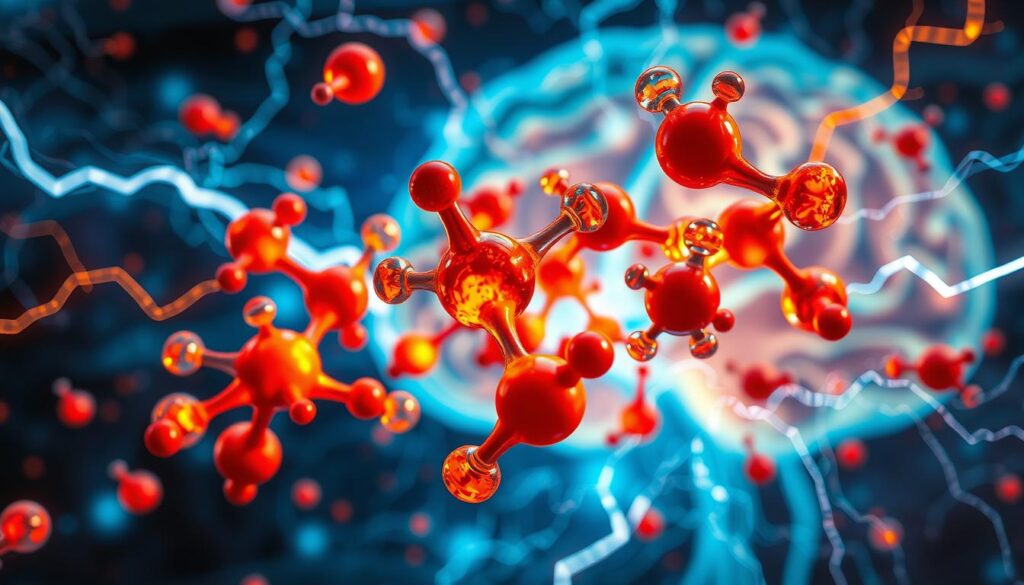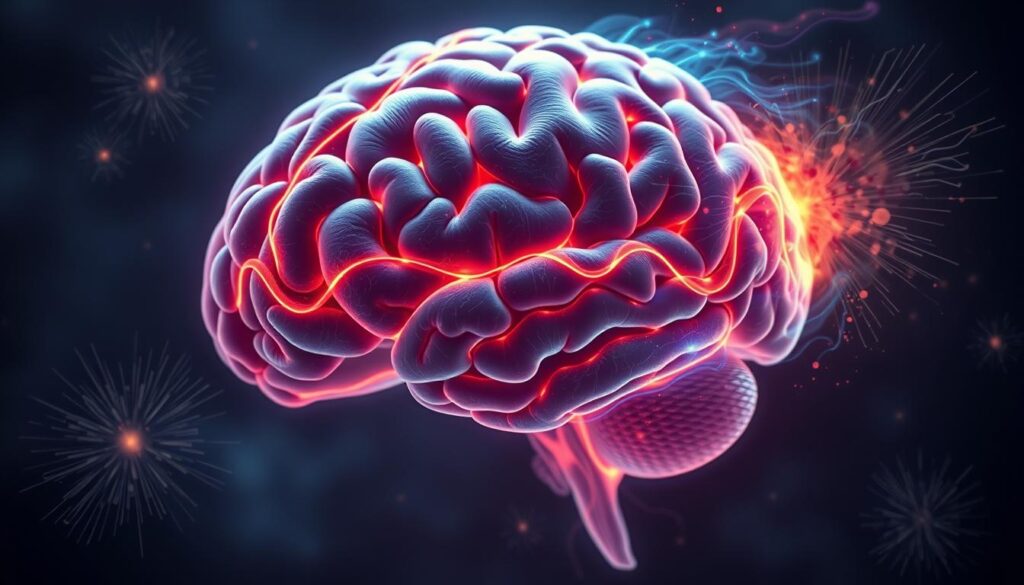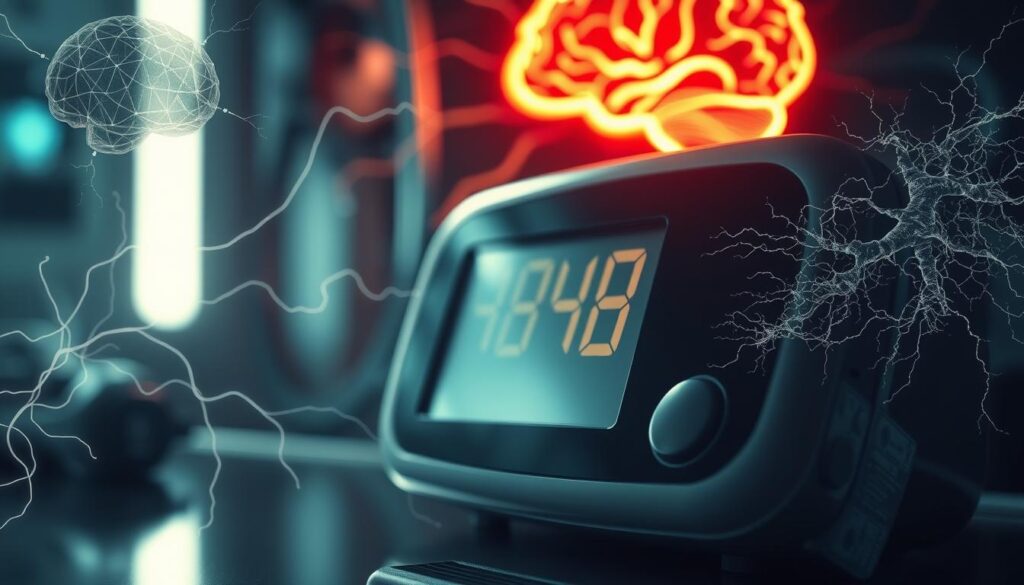High blood sugar, or hyperglycemia, can indeed lead to seizures in some individuals, particularly those with diabetes or other underlying health conditions. About 25% of people with diabetes may have a seizure because of blood sugar changes. Seizures can happen when blood sugar goes up a lot, usually over 125 mg/dL after fasting for at least 6 hours.
Both high and low blood sugar can cause seizures. But seizures from high blood sugar are more common in adults with diabetes. Seizures from uncontrolled blood sugar are serious and need quick attention to avoid more problems.
Key Takeaways
- Approximately 25% of individuals with diabetes may experience seizures due to high blood sugar.
- Seizures can occur when blood sugar levels are above 125 mg/dL after fasting for at least 6 hours.
- Both hyperglycemia and hypoglycemia can lead to seizures, but hyperglycemia-induced seizures are more common in adults with diabetes.
- Seizures related to hyperglycemia are potentially fatal and should be taken seriously.
- Hyperglycemic seizures may lead to complications such as involuntary movements or loss of consciousness.
Understanding the Link Between Blood Sugar and Seizures
Glucose is the brain’s main fuel. It’s vital for brain health. When blood sugar levels are off, brain function can suffer. This can lead to seizures.
The balance between glucose and brain activity is important. It helps us understand how blood sugar and seizures are connected.
The Role of Glucose in Brain Function
The brain needs glucose to work right. Neurons, the brain’s signal senders, use glucose for energy. Without enough glucose, neurons can get too excited. This can cause seizures.
Normal vs. Abnormal Blood Sugar Levels
Healthy blood sugar is between 70 to 100 mg/dL. People with diabetes often have too much sugar in their blood. This is called hyperglycemia.
High blood sugar can lower GABA levels. GABA helps keep neurons calm. Low GABA levels make seizures more likely.
Impact on Neurological Health
High and low blood sugar are bad for the brain. Hypoglycemic seizures happen when blood sugar is too low. Diabetic emergency seizures happen when blood sugar is too high.
These seizures can cause confusion, coma, and even death. It’s important to keep blood sugar in check.
By managing blood sugar, we can prevent seizures. Healthy blood sugar levels are key to good brain health.
| Blood Sugar Level | Condition | Seizure Risk |
|---|---|---|
| 70-100 mg/dL | Normal | Low |
| Above 125 mg/dL | Hyperglycemia | Increased |
| Below 70 mg/dL | Hypoglycemia | Increased |
Can High Blood Sugar Cause Seizures: Exploring the Connection
Seizures are a serious medical issue. They can happen for many reasons, including high blood sugar. High blood sugar, or hyperglycemia, can cause seizures in people with diabetes or other metabolic problems. It’s important to understand how blood sugar and brain health are connected to manage and prevent seizures.
Research shows that high blood sugar can make seizures more likely. In fact, studies found that high glucose levels can make brain activity that leads to seizures. Low glucose levels, on the other hand, can stop this activity. This means high blood sugar can lead to seizures in both diabetic and non-diabetic people.
The exact reason why high blood sugar causes seizures is still being studied. But, it’s thought that high glucose levels might overexcite brain cells. Also, changes in the blood-brain barrier and chemical shifts during high blood sugar might contribute to seizures.
| Statistic | Value |
|---|---|
| Epilepsy prevalence globally | Approximately 50 million individuals |
| Diabetes prevalence worldwide | Around 463 million individuals |
| Percentage of diabetic patients with seizures due to Non-Ketotic Hyperglycemia (NKH) | 7.9% |
| Percentage of diabetic patients with seizures related to NKH without brain damage | 3.5% |
| Percentage of people with NKH who develop seizures | Approximately 25% |
People with both epilepsy and diabetes face higher healthcare costs and challenges. It’s key to know the signs of seizures caused by high blood sugar. These signs include sudden confusion, disorientation, and loss of consciousness. Knowing these signs can help get help quickly.
To lower the risk of seizures from high blood sugar, people with diabetes or metabolic disorders should keep their blood sugar in check. This can be done through healthy lifestyle choices, regular blood sugar checks, and following treatment plans. Working closely with healthcare providers is crucial to manage blood sugar and brain health effectively.
Types of Hyperglycemia-Related Seizures
There are two main types of uncontrolled diabetes seizures. These are Nonketotic Hyperglycemia (NKH) and Ketotic Hyperglycemia. Knowing the difference is key to managing and preventing diabetic seizures.
Nonketotic Hyperglycemia (NKH)
NKH, also called Hyperosmolar Hyperglycemic Syndrome (HHS), happens when blood sugar is very high. It can cause seizures, odd movements, and even coma. About 25 percent of people with NKH have hyperglycemia seizures.
Ketotic Hyperglycemia and Diabetic Ketoacidosis
Ketotic Hyperglycemia, including Diabetic Ketoacidosis (DKA), happens when the body burns fat for energy. This releases ketones into the blood, causing seizures. People with type 1 diabetes are at high risk of DKA seizures.
Clinical Manifestations
Seizures from high blood sugar can show up differently. Seizures from low blood sugar often happen when sleeping and are more common in kids. Focal seizures, affecting one brain area, are linked to NKH and can hit anyone with diabetes.
More research is needed to understand hyperglycemia seizures and brain functions.
Recognizing the Warning Signs of Diabetic Seizures
If you have diabetes, knowing the signs of diabetic seizures is key. These seizures happen when your blood sugar goes up or down too fast. This can be because of too much sugar (hyperglycemia) or too little sugar (hypoglycemia).
Some common signs of an upcoming diabetic seizure include:
- Temporary confusion or disorientation
- Loss of consciousness
- Uncontrollable jerking of the limbs
- Profuse sweating
- Feelings of anxiety or fear
- Changes in vision
When you’re having a seizure, you might feel:
- Uncontrollable muscle spasms
- Drooling
- Falling to the ground
- Teeth clenching
- Tongue biting
- Rapid eye movements
- Loss of bowel or bladder control
Diabetic seizures usually don’t last more than 5 minutes. But, they can be very dangerous if they keep happening. Getting help right away is very important for your safety.
“Untreated diabetic ketoacidosis can lead to diabetic seizures, diabetic comas, and in severe cases, can be fatal.”
Knowing these signs and symptoms helps you manage your blood sugar. This can lower the chance of these serious events happening.
The Science Behind Hyperglycemic Seizures
Hyperglycemic seizures happen when blood sugar gets too high. This high sugar messes with how brain cells work. It can cause sudden electrical activity and seizures.
Neurological Mechanisms
High sugar levels change the balance of ions and neurotransmitters in the brain. This messes up how nerve cells talk to each other. It leads to abnormal firing of neurons, which is what causes seizures.
High sugar can also damage certain brain areas. This makes seizures more likely.
Blood-Brain Barrier Effects
The blood-brain barrier helps control what gets into the brain. High blood sugar can damage this barrier. This lets bad stuff into the brain and messes with its balance.
This can start seizures.
Chemical Changes During Episodes
During a seizure caused by high blood sugar, the brain goes through big changes. The normal electrical patterns get disrupted. This changes the levels of neurotransmitters and ions.
These changes make seizures worse and cause other symptoms.
Researchers are still learning about glucose regulation seizures, hyperglycemia seizures, and diabetic emergency seizures. Things like the immune system, genes, and the environment might also play a role.
| Condition | Incidence of Seizures | Potential Causes |
|---|---|---|
| Nonketotic Hyperglycemia (NKH) | Estimated 25% of cases | Disruption of neuronal signaling, blood-brain barrier dysfunction |
| Ketotic Hyperglycemia and Diabetic Ketoacidosis | More common in type 1 diabetes | Severe metabolic disturbances, electrolyte imbalances |
| Febrile Seizures | Correlated with stress hyperglycemia | Transient high blood glucose, metabolic disturbances |

It’s important to understand the science behind hyperglycemic seizures. This helps doctors treat and prevent these serious events in people with diabetes or other metabolic problems.
Treatment Approaches for Blood Sugar-Induced Seizures
Managing seizures caused by high blood sugar needs a careful plan. Doctors aim to quickly lower blood sugar and fix any metabolic problems.
Insulin is key in treatment. Doctors watch and adjust insulin doses to keep blood sugar normal. They also give IV fluids to help with insulin and fluids.
Potassium is often needed to balance electrolytes. For seizures caused by low blood sugar, glucagon is used to quickly increase blood sugar.
- Insulin therapy to lower blood sugar levels
- IV fluids to address fluid imbalances and insulin resistance
- Potassium replacement to maintain electrolyte balance
- Glucagon for hypoglycemic seizures to increase blood glucose
- Anti-seizure medications may be prescribed in some cases
In some cases, doctors might give anti-seizure meds. This helps keep the brain stable and stops seizures. The treatment plan is made just for the patient and their specific problem.
“Effective management of blood sugar-induced seizures requires a multifaceted approach, focusing on rapid normalization of glucose levels and supporting the body’s physiological processes.”
Doctors work hard to stop seizures from coming back. They help improve brain health for people with diabetic seizures, hyperglycemia seizures, or glucose regulation seizures.
Prevention Strategies and Blood Sugar Management
Keeping your blood sugar stable is key to avoiding diabetic seizures. You need to make lifestyle changes and check your levels often.
Lifestyle Modifications
Eating right and exercising can help a lot. Eat foods full of nutrients and watch your carbs. Move for 30 minutes each day to keep your sugar levels steady.
Don’t forget to take your diabetes meds as told. This helps keep your sugar levels safe and lowers seizure risk.
Monitoring Techniques
- Use a glucose meter to check your sugar levels often. This helps you see patterns and adjust your plan.
- Think about getting a continuous glucose monitoring (CGM) system. It shows your sugar levels in real time, helping you act fast.
- Consider getting a diabetes alert dog. They can sense when your sugar is off and warn you before a seizure.
Working with your healthcare team is very important. They can help you make a plan to control your sugar and avoid seizures. This includes blood glucose levels seizures, uncontrolled diabetes seizures, and diabetic emergency seizures.

“Keeping your blood sugar levels in a healthy range is the best way to prevent seizures related to your diabetes. With the right strategies and support, you can take control of your condition and enjoy a better quality of life.”
Emergency Response and Medical Interventions
Quick action is key when someone has a diabetic seizure. First, make sure they’re safe. Remove things that could hurt them and put them on their side. Don’t put anything in their mouth to avoid blocking their airway.
Then, call for emergency help right away. Diabetic seizures are serious and need a doctor’s help fast. Doctors might give insulin or fluids to help.
If the seizure lasts over 5 minutes or keeps happening, call 911. This is a big emergency. Quick help is needed to avoid serious problems like brain damage or death.
Knowing how to act in a diabetic seizure can save lives. Stay calm, keep the person safe, and call for help fast. We can all help by being ready for these emergencies.
| Condition | Prevalence |
|---|---|
| Type 1 Diabetes Mellitus (T1DM) | 5-10% of all diabetes cases |
| Type 2 Diabetes Mellitus (T2DM) | Around 90% of all diabetes cases |
| Gestational Diabetes Mellitus | Affects around 7% of pregnancies |
1 to 2 percent of emergency calls are for low blood sugar. This can cause seizures. Anyone can have a seizure, but kids and older adults are more at risk. Seizures from blood sugar problems need quick doctor help.
“Seizures can lead to injuries from falls or accidents due to loss of consciousness and convulsions.”
Status epilepticus is very dangerous. It’s when a seizure lasts too long or happens too often. It can hurt the brain and even be deadly. Knowing how to act in emergencies can save lives.
Conclusion
High blood sugar can indeed cause seizures, especially in people with diabetes. Both high and low blood sugar can lead to seizures. But seizures caused by high blood sugar are more common in adults.
Understanding how blood sugar and seizures are linked is key. Knowing the warning signs and managing blood sugar well is important. With the right care and lifestyle changes, the risk of seizures can drop a lot.
The brain uses a lot of glucose, and seizures can make it use even more. Changes in blood sugar can also lead to seizures that don’t respond to drugs. Knowing this helps people with diabetes manage their condition better.
To stop seizures caused by high blood sugar, keep blood sugar levels healthy. This means getting the right treatment, making lifestyle changes, and checking blood sugar often. By tackling the problem head-on, people with diabetes can live better lives.


A Life-Changing Experience with This Weight Loss Supplement (Nagano Tonic)
I’ve always struggled with finding a weight loss solution that actually works for me. Like many, I’ve tried numerous diets, exercise routines, and supplements over the years—some worked for a short time, but nothing ever gave me long-term results. That was until I decided to try the weight loss supplement I found : Link to the Supplement.
From the moment I started using it, I noticed a difference. Not only did I feel more energized, but my cravings also became more manageable. The best part? I started seeing results much quicker than I anticipated! Over the course of just a few weeks, I noticed a significant reduction in belly fat and overall weight loss that I hadn’t been able to achieve before.
What makes this supplement stand out from all the others I’ve tried is how it supports me in my daily routine without any jitters or energy crashes. I’m able to stay focused and motivated, which has made it easier to stay on track with my diet and exercise plan.
This product truly exceeded my expectations, and I feel more confident and healthier than ever before. If you’re struggling with your weight loss journey like I was, I highly recommend giving this supplement a try. It’s been a game-changer for me, and I’m sure it can work wonders for you too!
Contant Them on email .. tonicnagano50@gmail.com
I’ve tried so many weight loss products over the years, but nothing worked like this supplement! Since I started using it, I’ve noticed a big difference in my energy levels and appetite control. In just a few weeks, I’ve lost weight and feel so much better. It’s been easy to stick with, and the results speak for themselves. Highly recommend this to anyone looking to make a real change!
This Nagano Tonic has been amazing! In just a few weeks, I’ve lost weight, feel more energized, and my cravings are under control. Highly recommend it!
Thats the link to purchase http://surl.li/iasppy